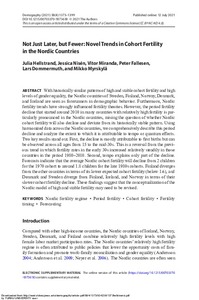Not just later, but fewer: novel trends in cohort fertility in the Nordic countries
Dommermuth Lars; Fallesen Peter; Hellstrand Julia; Miranda Vitor; Myrskylä Mikko; Nisén Jessica
https://urn.fi/URN:NBN:fi-fe2021093048008
Tiivistelmä
With historically similar patterns of high and stable cohort fertility and high levels of gender equality, the Nordic countries of Sweden, Finland, Norway, Denmark, and Iceland are seen as forerunners in demographic behavior. Furthermore, Nordic fertility trends have strongly influenced fertility theories. However, the period fertility decline that started around 2010 in many countries with relatively high fertility is particularly pronounced in the Nordic countries, raising the question of whether Nordic cohort fertility will also decline and deviate from its historically stable pattern. Using harmonized data across the Nordic countries, we comprehensively describe this period decline and analyze the extent to which it is attributable to tempo or quantum effects. Two key results stand out. First, the decline is mostly attributable to first births but can be observed across all ages from 15 to the mid-30s. This is a reversal from the previous trend in which fertility rates in the early 30s increased relatively steadily in those countries in the period 1980–2010. Second, tempo explains only part of the decline. Forecasts indicate that the average Nordic cohort fertility will decline from 2 children for the 1970 cohort to around 1.8 children for the late 1980s cohorts. Finland diverges from the other countries in terms of its lower expected cohort fertility (below 1.6), and Denmark and Sweden diverge from Finland, Iceland, and Norway in terms of their slower cohort fertility decline. These findings suggest that the conceptualization of the Nordic model of high and stable fertility may need to be revised.
Kokoelmat
- Rinnakkaistallenteet [19207]
